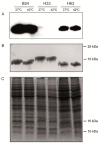Differential Distribution of the wlaN and cgtB Genes, Associated with Guillain-Barré Syndrome, in Campylobacter jejuni Isolates from Humans, Broiler Chickens, and Wild Birds
- PMID: 32110976
- PMCID: PMC7142995
- DOI: 10.3390/microorganisms8030325
Differential Distribution of the wlaN and cgtB Genes, Associated with Guillain-Barré Syndrome, in Campylobacter jejuni Isolates from Humans, Broiler Chickens, and Wild Birds
Abstract
Campylobacter jejuni causes campylobacteriosis, a bacterial gastroenteritis with high incidence worldwide. Moreover, C. jejuni infection can trigger the polyneuropathic disorder denominated Guillain-Barré syndrome (GBS). The C. jejuni strains that can elicit GBS carry either wlaN or cgtB, coding both genes for a β-1,3-galactosyltransferase enzyme that is required for the production of sialylated lipooligosaccharide (LOSSIAL). We described a differential prevalence of the genes wlaN and cgtB in C. jejuni isolates from three different ecological niches: humans, broiler chickens, and wild birds. The distribution of both genes, which is similar between broiler chicken and human isolates and distinct when compared to the wild bird isolates, suggests a host-dependent distribution. Moreover, the prevalence of the wlaN and cgtB genes seems to be restricted to some clonal complexes. Gene sequencing identified the presence of new variants of the G- homopolymeric tract within the wlaN gene. Furthermore, we detected two variants of a G rich region within the cgtB gene, suggesting that, similarly to wlaN, the G-tract in the cgtB gene mediates the phase variation control of cgtB expression. Caco-2 cell invasion assays indicate that there is no evident correlation between the production of LOSSIAL and the ability to invade eukaryotic cells.
Keywords: Campylobacter; Guillain-Barré syndrome; cgtB; lipooligosaccharide; wlaN.
Conflict of interest statement
The authors declare no conflict of interest.
Figures




Similar articles
-
Comparison of lipooligosaccharide biosynthesis genes of Campylobacter jejuni strains with varying abilities to colonize the chicken gut and to invade Caco-2 cells.J Med Microbiol. 2007 Dec;56(Pt 12):1589-1594. doi: 10.1099/jmm.0.47305-0. J Med Microbiol. 2007. PMID: 18033824
-
Distribution of genes related to Type 6 secretion system and lipooligosaccharide that induced ganglioside mimicry among Campylobacter jejuni isolated from human diarrhea in Thailand.Gut Pathog. 2020 Apr 9;12:18. doi: 10.1186/s13099-020-00357-6. eCollection 2020. Gut Pathog. 2020. PMID: 32308743 Free PMC article.
-
PCR detection of virulence-associated genes in Campylobacter jejuni strains with differential ability to invade Caco-2 cells and to colonize the chick gut.Vet Microbiol. 2006 Mar 10;113(1-2):123-9. doi: 10.1016/j.vetmic.2005.10.029. Epub 2005 Nov 21. Vet Microbiol. 2006. PMID: 16300911
-
Distribution of virulence and antibiotic resistance genes in Campylobacter jejuni and Campylobacter coli isolated from broiler chickens in Tunisia.J Microbiol Immunol Infect. 2022 Dec;55(6 Pt 2):1273-1282. doi: 10.1016/j.jmii.2021.07.001. Epub 2021 Jul 17. J Microbiol Immunol Infect. 2022. PMID: 34340908 Review.
-
Ganglioside mimicry as a cause of Guillain-Barré syndrome.Curr Opin Neurol. 2005 Oct;18(5):557-61. doi: 10.1097/01.wco.0000174604.42272.2d. Curr Opin Neurol. 2005. PMID: 16155440 Review.
Cited by
-
Draft Genome Sequences of Three Strains of Campylobacter jejuni Isolated from Patients with Guillain-Barré Syndrome in Bangladesh.Microbiol Resour Announc. 2021 Apr 29;10(17):e00005-21. doi: 10.1128/MRA.00005-21. Microbiol Resour Announc. 2021. PMID: 33927026 Free PMC article.
-
Foodborne Pathogen Campylobacter.Microorganisms. 2021 Jun 8;9(6):1241. doi: 10.3390/microorganisms9061241. Microorganisms. 2021. PMID: 34200984 Free PMC article.
-
Whole-genome-based characterization of Campylobacter jejuni from human patients with gastroenteritis collected over an 18 year period reveals increasing prevalence of antimicrobial resistance.Microb Genom. 2023 Feb;9(2):mgen000941. doi: 10.1099/mgen.0.000941. Microb Genom. 2023. PMID: 36809179 Free PMC article.
-
A New Variant of the aadE-sat4-aphA-3 Gene Cluster Found in a Conjugative Plasmid from a MDR Campylobacter jejuni Isolate.Antibiotics (Basel). 2022 Mar 30;11(4):466. doi: 10.3390/antibiotics11040466. Antibiotics (Basel). 2022. PMID: 35453217 Free PMC article.
-
The Distribution of Campylobacter jejuni Virulence Genes in Genomes Worldwide Derived from the NCBI Pathogen Detection Database.Genes (Basel). 2021 Sep 28;12(10):1538. doi: 10.3390/genes12101538. Genes (Basel). 2021. PMID: 34680933 Free PMC article.
References
-
- Blaser M.J., Engberg J. Clinical and Epidemiological Aspects of Campylobacter Infections. In: Nachamkin I., Szymanski C., editors. Campylobacter. 3rd ed. ASM Press; Washington, DC, USA: 2008. pp. 99–121.

